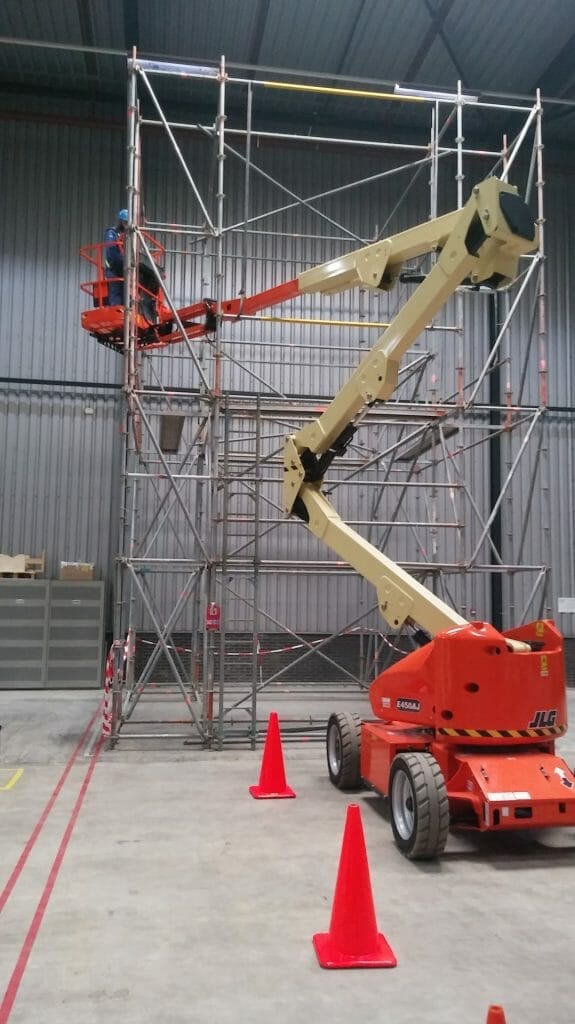AWP courses 3A and 3B: what are the differences?
There are aerial platforms in various categories. For example, there are aerial work platforms on a trailer, spider work platforms with outriggers, self-propelled scissor lifts and articulated telescopic work platforms. The Working Conditions Act, but also the Safety Checklist for Contractors (VCA), set requirements for the use of aerial work platforms. For example, users must be demonstrably instructed in the operation of the machines. People who use an aerial work platform to carry out their work must therefore have followed a training course appropriate to the type of aerial work platform and have obtained a corresponding certificate. In this article, we explain the difference between the various types of AWPs and the training that goes with them.
Different types of aerial platforms; 1A, 1B, 3A and 3B
Aerial platforms are divided into four different categories. The main distinction is made between self-propelled and non-self-propelled AWPs. Self-propelled AWPs fall into category 3. Non-self-propelled AWPs are categorized in category 1. However, from the (petro)chemical industry, the maritime sector and the construction industry, the demand is greatest for training for self-propelled work platforms in categories 3A and 3B. Below is an overview of the various types of aerial work platforms per category.
Category 1A
These are vertically working, one-person stamped aerial platforms. These platforms are not movable and are only accessible to one person. They are also called one-man lifts.
Category 1B
Telescopic and articulated boom lifts, boom lifts on a trailer or chassis and spider lifts with outriggers belong to category 1B. Stamped platforms are permanently installed, the platforms on a chassis or trailer can be moved.
Category 3A
Self-propelled scissor lifts and self-propelled single-section vertical lift AWPs belong to category 3A. The lifting mechanism of these boom lifts is scissor shaped, which ensures that the boom lift can raise the platform to the desired height by means of vertical movement.
Category 3B
Within category 3B are the self-propelled telescopic and articulated boom lifts. Due to their flexible lifting, these work platforms can reach places that are not accessible with type 3A work platforms.
When to use which type of aerial work platform depends on a number of factors. Will you be working indoors or outdoors? At what height will the work take place? Are there any obstacles along or around which you need to manoeuvre? Can the aerial work platform go straight up or does it have to bend around certain structures? What space is available? What is the required lifting capacity? And on what surface will the aerial platform be placed?

In which situation do you need which certificate?
As stated earlier, it is determined by occupational health and safety legislation that you must be demonstrably trained to operate the type of aerial work platform that you work with in practice. Additional requirements may be set by VCA or SOG, for example. Which certificate you need therefore depends on, for example, the branch in which you work or which requirements a client has. In our training centre, we make a distinction between the DELTA certificate and the SOG certificate. The difference between a DELTA and SOG certificate is explained in detail in our blog. If, for example, you only want to follow the AWP 1A or 1B course, it is also possible to obtain a SOG subcertificate.
AWP category 3A

What is the difference between the aerial work platform course 3A and 3B?
The main difference between category 3A and 3B AWPs is the lifting mechanism. Category 3A AWPs only allow vertical movement and require you to be able to position the AWP straight under the work. Category 3B AWPs allow you to manoeuvre around obstacles in height. The aerial work platform course 3A is mainly aimed at teaching students how to manoeuvre in a confined space. In the aerial work platforms course 3B, students additionally learn how to position the working platform in a prescribed construction. In both practical training courses, the course participants get a good idea of working at great heights. For example, eight metres is the minimum height at which an exam must be taken. The theory for the different types of training is the same.
AWP category 3B
Interactive aerial work platform course Rotterdam
At DELTA Safety Training, we find it important that our participants not only enter the exam well prepared and obtain their certificate, but above all that they can apply the knowledge they have acquired in daily work situations in practice. Our trainers follow the prescribed guidelines, but they also interact with the participants as much as possible. This way, we not only get a better picture of situations that people face on a daily basis, but we can also tailor the teaching material to these different situations. With a background and work experience in the various sectors on which our training courses focus, our trainers know better than anyone else what course participants may have to deal with. This way, they can outline relevant example situations of how theoretical knowledge is applied correctly in practice.
Would you like to know more about our aerial work platform course? Our colleague Remy de Jong would be happy to go over the possibilities with you! Fill out the form below and we will contact you personally.
